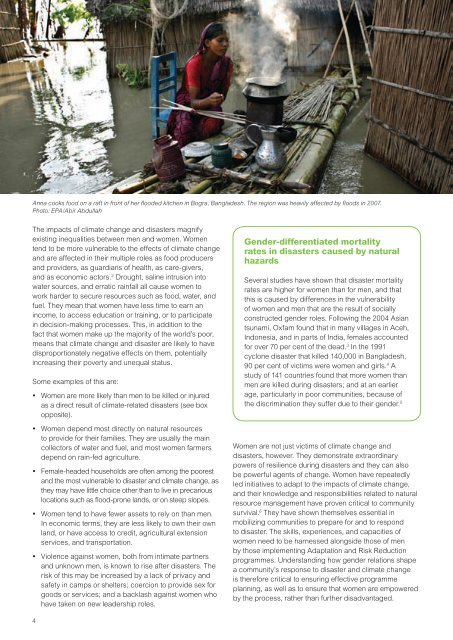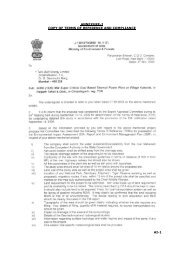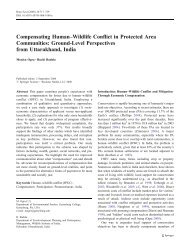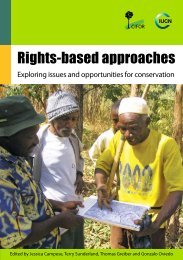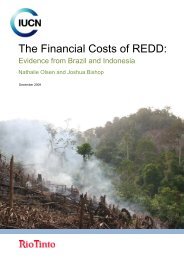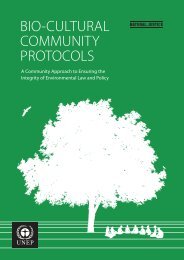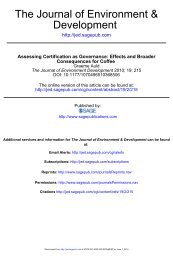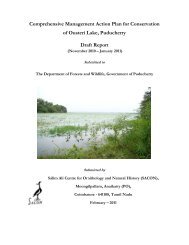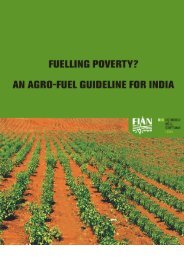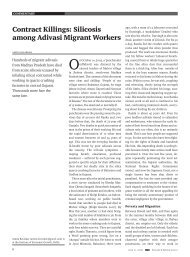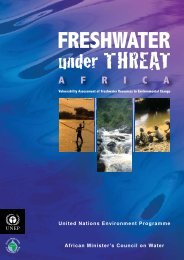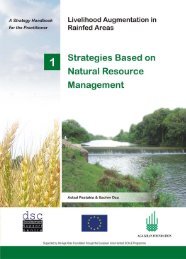Gender, Disaster Risk Reduction, and Climate Change Adaptation
Gender, Disaster Risk Reduction, and Climate Change Adaptation
Gender, Disaster Risk Reduction, and Climate Change Adaptation
Create successful ePaper yourself
Turn your PDF publications into a flip-book with our unique Google optimized e-Paper software.
Anna cooks food on a raft in front of her flooded kitchen in Bogra, Bangladesh. The region was heavily affected by floods in 2007.<br />
Photo: EPA/Abir Abdullah<br />
The impacts of climate change <strong>and</strong> disasters magnify<br />
existing inequalities between men <strong>and</strong> women. Women<br />
tend to be more vulnerable to the effects of climate change<br />
<strong>and</strong> are affected in their multiple roles as food producers<br />
<strong>and</strong> providers, as guardians of health, as care-givers,<br />
<strong>and</strong> as economic actors. 2 Drought, saline intrusion into<br />
water sources, <strong>and</strong> erratic rainfall all cause women to<br />
work harder to secure resources such as food, water, <strong>and</strong><br />
fuel. They mean that women have less time to earn an<br />
income, to access education or training, or to participate<br />
in decision-making processes. This, in addition to the<br />
fact that women make up the majority of the world’s poor,<br />
means that climate change <strong>and</strong> disaster are likely to have<br />
disproportionately negative effects on them, potentially<br />
increasing their poverty <strong>and</strong> unequal status.<br />
Some examples of this are:<br />
• Women are more likely than men to be killed or injured<br />
as a direct result of climate-related disasters (see box<br />
opposite).<br />
• Women depend most directly on natural resources<br />
to provide for their families. They are usually the main<br />
collectors of water <strong>and</strong> fuel, <strong>and</strong> most women farmers<br />
depend on rain-fed agriculture.<br />
• Female-headed households are often among the poorest<br />
<strong>and</strong> the most vulnerable to disaster <strong>and</strong> climate change, as<br />
they may have little choice other than to live in precarious<br />
locations such as flood-prone l<strong>and</strong>s, or on steep slopes.<br />
• Women tend to have fewer assets to rely on than men.<br />
In economic terms, they are less likely to own their own<br />
l<strong>and</strong>, or have access to credit, agricultural extension<br />
services, <strong>and</strong> transportation.<br />
• Violence against women, both from intimate partners<br />
<strong>and</strong> unknown men, is known to rise after disasters. The<br />
risk of this may be increased by a lack of privacy <strong>and</strong><br />
safety in camps or shelters; coercion to provide sex for<br />
goods or services; <strong>and</strong> a backlash against women who<br />
have taken on new leadership roles.<br />
<strong>Gender</strong>-differentiated mortality<br />
rates in disasters caused by natural<br />
hazards<br />
Several studies have shown that disaster mortality<br />
rates are higher for women than for men, <strong>and</strong> that<br />
this is caused by differences in the vulnerability<br />
of women <strong>and</strong> men that are the result of socially<br />
constructed gender roles. Following the 2004 Asian<br />
tsunami, Oxfam found that in many villages in Aceh,<br />
Indonesia, <strong>and</strong> in parts of India, females accounted<br />
for over 70 per cent of the dead. 3 In the 1991<br />
cyclone disaster that killed 140,000 in Bangladesh,<br />
90 per cent of victims were women <strong>and</strong> girls. 4 A<br />
study of 141 countries found that more women than<br />
men are killed during disasters; <strong>and</strong> at an earlier<br />
age, particularly in poor communities, because of<br />
the discrimination they suffer due to their gender. 5<br />
Women are not just victims of climate change <strong>and</strong><br />
disasters, however. They demonstrate extraordinary<br />
powers of resilience during disasters <strong>and</strong> they can also<br />
be powerful agents of change. Women have repeatedly<br />
led initiatives to adapt to the impacts of climate change,<br />
<strong>and</strong> their knowledge <strong>and</strong> responsibilities related to natural<br />
resource management have proven critical to community<br />
survival. 6 They have shown themselves essential in<br />
mobilizing communities to prepare for <strong>and</strong> to respond<br />
to disaster. The skills, experiences, <strong>and</strong> capacities of<br />
women need to be harnessed alongside those of men<br />
by those implementing <strong>Adaptation</strong> <strong>and</strong> <strong>Risk</strong> <strong>Reduction</strong><br />
programmes. Underst<strong>and</strong>ing how gender relations shape<br />
a community’s response to disaster <strong>and</strong> climate change<br />
is therefore critical to ensuring effective programme<br />
planning, as well as to ensure that women are empowered<br />
by the process, rather than further disadvantaged.<br />
4


